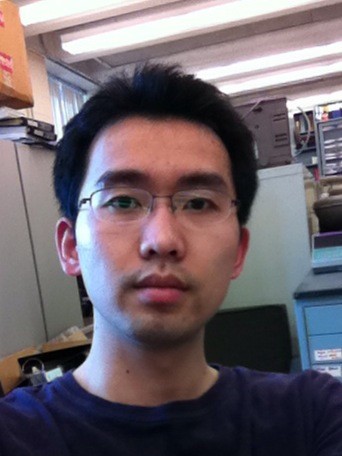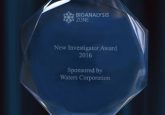2017 New Investigator Award: Mu Chen

 Mu Chen (Frontage Laboratory, USA)
Mu Chen (Frontage Laboratory, USA)
What made you chose a career in bioanalysis?
After completing my graduate research in physical organic chemistry with High Resolution Mass Spectrometry (HRMS) as a powerful qualitative tool, I became very interested in the quantitative nature of mass spectrometry, especially its applications in detecting target molecules from a complex matrix. To pursue such an interest after my Ph.D. study, I joined Frontage Laboratories in 2014, where I had the opportunity to tackle many bioanalytical challenges by using the combined powers of mass spectrometry and many other separation techniques. Meanwhile, I was truly inspired by how many of the LC-MS based bioanalytical methods (including the ones that I developed) strongly supported the development of innovative and safe pharmaceuticals.
Describe the main highlights of your bioanalytical work?
My bioanalytical work has focused on the development of novel LC-MS methods for the quantitation of both small and large pharmaceutical substances in various types of biological matrices. I am very interested in the optimization of sample pretreatment, HPLC separation, and mass spectrometry conditions to solve analytical challenges, including development of highly sensitive methods, simultaneous quantitation of multiple analytes, and quantitation of endogenous analytes.
For large molecule bioanalysis, my work included quantitation of oligonucleotides, antibody drugs, peptides, and endogenous glycosaminoglycans by developing methods based on LC-MS platforms. For example, I developed several affinity capture-LC-MS/MS methods for mAbs with LLOQ in the 5-50 ng/mL range, which greatly improved the quantitation limit of this category of molecules in plasma samples. In addition to the “bottom-up” approach for mAb quantitation, my recent work also included application of HRMS on the DAR determination of ADC drugs and intact protein quantitation.
I am also interested in the investigation of several critical issues for pharmaceutical bioanalysis, including measurement of red blood cell partitioning, protein binding, and microsampling of blood specimen.
How has your work impacted your laboratory, the bioanalytical field and beyond?
The bioanalytical methods and techniques that I established at Frontage has supported numerous pharmaceutical studies, including discovery, animal, and clinical studies. In a pharmaceutical CRO company, the bioanalytical goals can be challenging and unique to each specific drug candidate. For example, we developed an ultra-sensitive quantitation method at the low pg/mL level for the detection of a probe drug for a drug-to-drug interaction study; while in another project, we set up an affinity capture-LC-HRMS method for the calculation of different species of an ADC drug. By using the analytical knowledge and applying new techniques in bioanalysis, I am excited about delivering solid analytical results from our laboratory to the collaborators, and supporting the pharmaceutical bioanalysis of many important drugs. Some of these drugs were approved by US FDA with my bioanalytical work in the application package.
I am currently leading a group of scientists working on the bioanalysis of large molecule drugs, which are increasingly important among the categories of drug candidates. My bioanalytical work in this field has helped the understanding of the structure characteristics, pharmacokinetics, as well as metabolism nature of these drug candidates.
Describe the most difficult challenge you have encountered in your scientific career and how you overcame it?
The most difficult challenge I have encountered in my career is the quantitation of a monoclonal antibody (mAb) in human plasma. My goal was to develop an LC-MS/MS based bioanalytical method for the quantitation and achieve a target LLOQ of 50 ng/mL. To achieve the highest sensitivity, I chose affinity capture purification as the sample pretreatment method. I also optimized the HPLC conditions and mass spectrometry parameters for several high response surrogate peptides from the mAb. With these conditions optimized, I was still 10 fold away from the target LLOQ. I exhausted all the LC-MS/MS conditions at this point and could not push the LLOQ further.
To solve this issue, I thought the sample pretreatment step would be the key to further increase sensitivity. Such pretreatment has multiple steps (affinity capture, denaturation, reduction, alkylation, and digestion) and I decided to find the conditions that are most efficient for each step. I started by evaluating the recovery for each step and found that the affinity capture efficiency was less than 10% and there was certainly a large space to improve it. I therefore coated various types of affinity capture reagents on the magnetic beads and compared their performance. One of the reagents stood out and provided larger than 60% recovery. This improvement, along with the optimization of the other steps, provided a large enhancement of the method’s sensitivity. With this, I was able to achieve the target LLOQ of 50 ng/mL. The method is now validated and used for a clinical study.
Describe your role in bioanalytical communities/groups?
I have been publishing my work on a regular basis (1~2 journal papers per year) and the two most recent papers are in the field of bioanalysis. I also translated two book chapters in the Handbook of LC-MS Bioanalysis from English (Wiley) to Chinese. I also volunteered as reviewer or editorial member for several bioanalytical journals. In addition, I have been actively involved in the scientific discussions in the bioanalytical communities, by attending both national and regional conferences and discussion groups (e.g. ASMS, Delaware Drug Metabolism Discussion Group).
List up to five of your publications in the field of bioanalysis:
1 M. Chen, W. Lu, Y. Lu, L. Kang, H. Zhao, Z.-J. Lin, W. Wang, D. Fraier, and G. Ottaviani, “An ultra-sensitive LC–MS/MS method to determine midazolam levels in human plasma: development, validation and application to a clinical study”, Bioanalysis, 2017, 9, 3, 297-312.
2 M.-Q. Huang, L. Kang, W. Wang, D. Skee, M. Chen, Z. Lin, T. Verhaeghe, and N. Weng, “UPLC-MS/MS Assay for the Simultaneous Determination of Ethinyl Estradiol, Norgestimate and 17-Desacetyl Norgestimate at Low pg/mL in Human Plasma”, J. Chromatography B, 2016, 1017, 1-9.
3 Z.-J. Lin, W. Li, and N. Weng, Chapter 6 of Handbook of LC-MS Bioanalysis: LC-MS Bioanalytical Method Transfer, Scientific Press in China, translated by M. Chen, K. Wang, and Z.-J. Lin, 2017.
4 Z.-J. Lin, M. Moyer, J. Zeng, J. Rajarao, and M. Hayes, Chapter 10 of Handbook of LC-MS Bioanalysis: Current Understanding of Bioanalysis Data Management and Trend of Regulations on Data Management, Scientific Press in China, translated by, K. Wang, M. Chen, and Z.-J. Lin, 2017.
5 L. Mallis, W. Zhang, Li Yuan, Z. J. Lin, M. Chen, “Development of a Low Volume Quantitative Plasma Analysis Method Using a Flexible Capillary Microsampling Technique”, Presented at the 64th Annual Conference on Mass Spectrometry, San Antonio, TX, 2016 (Poster).
Find out more about this year’s New Investigator Award, the judging panel and the rest of our nominees.




